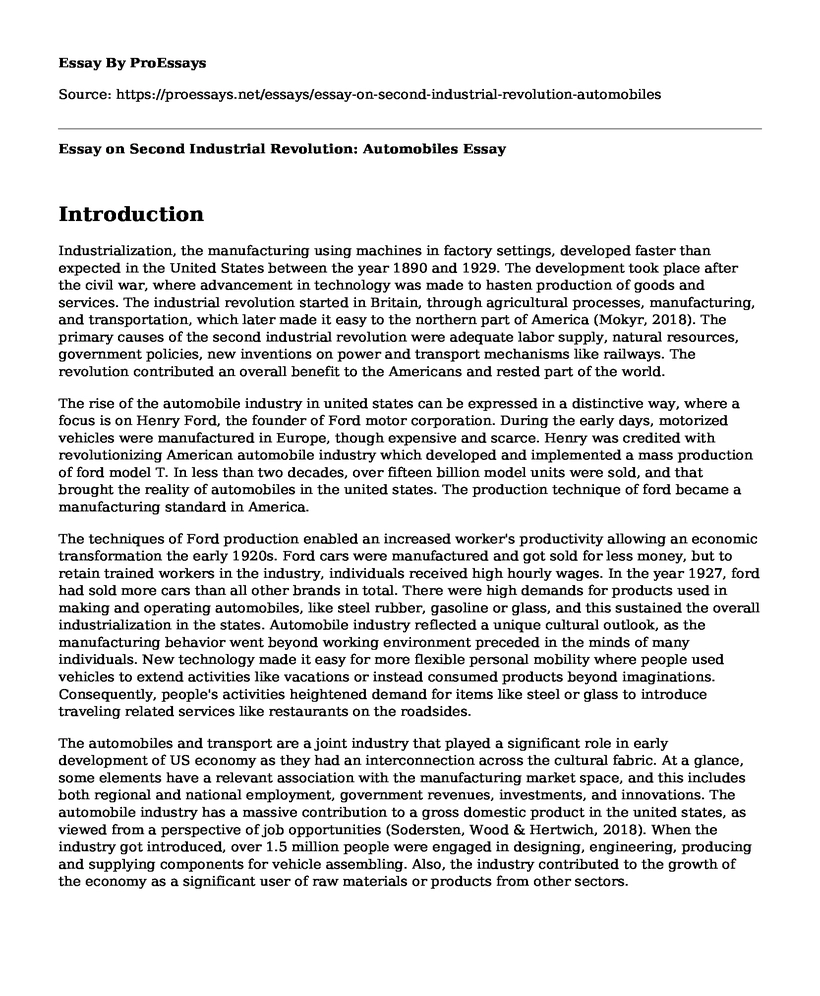Introduction
Industrialization, the manufacturing using machines in factory settings, developed faster than expected in the United States between the year 1890 and 1929. The development took place after the civil war, where advancement in technology was made to hasten production of goods and services. The industrial revolution started in Britain, through agricultural processes, manufacturing, and transportation, which later made it easy to the northern part of America (Mokyr, 2018). The primary causes of the second industrial revolution were adequate labor supply, natural resources, government policies, new inventions on power and transport mechanisms like railways. The revolution contributed an overall benefit to the Americans and rested part of the world.
The rise of the automobile industry in united states can be expressed in a distinctive way, where a focus is on Henry Ford, the founder of Ford motor corporation. During the early days, motorized vehicles were manufactured in Europe, though expensive and scarce. Henry was credited with revolutionizing American automobile industry which developed and implemented a mass production of ford model T. In less than two decades, over fifteen billion model units were sold, and that brought the reality of automobiles in the united states. The production technique of ford became a manufacturing standard in America.
The techniques of Ford production enabled an increased worker's productivity allowing an economic transformation the early 1920s. Ford cars were manufactured and got sold for less money, but to retain trained workers in the industry, individuals received high hourly wages. In the year 1927, ford had sold more cars than all other brands in total. There were high demands for products used in making and operating automobiles, like steel rubber, gasoline or glass, and this sustained the overall industrialization in the states. Automobile industry reflected a unique cultural outlook, as the manufacturing behavior went beyond working environment preceded in the minds of many individuals. New technology made it easy for more flexible personal mobility where people used vehicles to extend activities like vacations or instead consumed products beyond imaginations. Consequently, people's activities heightened demand for items like steel or glass to introduce traveling related services like restaurants on the roadsides.
The automobiles and transport are a joint industry that played a significant role in early development of US economy as they had an interconnection across the cultural fabric. At a glance, some elements have a relevant association with the manufacturing market space, and this includes both regional and national employment, government revenues, investments, and innovations. The automobile industry has a massive contribution to a gross domestic product in the united states, as viewed from a perspective of job opportunities (Sodersten, Wood & Hertwich, 2018). When the industry got introduced, over 1.5 million people were engaged in designing, engineering, producing and supplying components for vehicle assembling. Also, the industry contributed to the growth of the economy as a significant user of raw materials or products from other sectors.
Conclusion
A high multiplier effect for the automobile industry is on jobs created inside and outside the manufacturing plants, for instance in the assembly line. There is approximately eleven jobs multiplier for factory workers, meaning that a single job in the automobile assembly line creates or support ten positions in the overall economy. Sectoral multiplier effects inform which organizations or industries induce big bang for the buck in the marketplace. Typically, manufacturing operation has various substantial links with other economic sectors, and thus outputs stimulate more activities in the societyAs the outputs of automobile industry develop, it demands more inputs from utilities, mining or suppliers, while creating jobs and opening up opportunities for investments. Well, according to Gocha, Ross, Oney & De Guire, (2017), in united states, automakers are the main larger purchasers of materials like copper, aluminum, iron, plastic, computer chips, and textiles. The buying effort by the industry induce significant improvements in people's living standards and consequently raises the spending habit. In that way, the spending by individuals or governments pauses advantages in being potential consumers of automobile products.
References
Gocha, A., Ross, A., Oney, F., & De Guire, E. (2017). What's in and on that car? The role of ceramics and glass in the $4 trillion auto industry. American Ceramic Society Bulletin, 96(9), 10-23.
Mokyr, J. (2018). Editor's introduction: The new economic history and the Industrial Revolution. In the British industrial revolution (pp. 1-127). Routledge.
Sodersten, C. J., Wood, R., & Hertwich, E. G. (2018). Environmental impacts of capital formation. Journal of Industrial Ecology, 22(1), 55-67.
Cite this page
Essay on Second Industrial Revolution: Automobiles. (2022, May 30). Retrieved from https://proessays.net/essays/essay-on-second-industrial-revolution-automobiles
If you are the original author of this essay and no longer wish to have it published on the ProEssays website, please click below to request its removal:
- Historical Essay Sample: Colonia era, Exploration, and Discovery section
- Agriculture Crisis as a Cause of the Great Depression Essay
- Biography of Isaac Newton
- Implementation of International Humanitarian Law - Exploratory Essay
- Essay Sample on Russian Foreign Policy Motivations in the Ukraine Crisis of 2014
- Sectionalism: The Growing Divide Between North & South US - Essay Sample
- Comparative Analysis of John Brown and Timothy McVeigh: Terrorism, Motivations, and Methods







